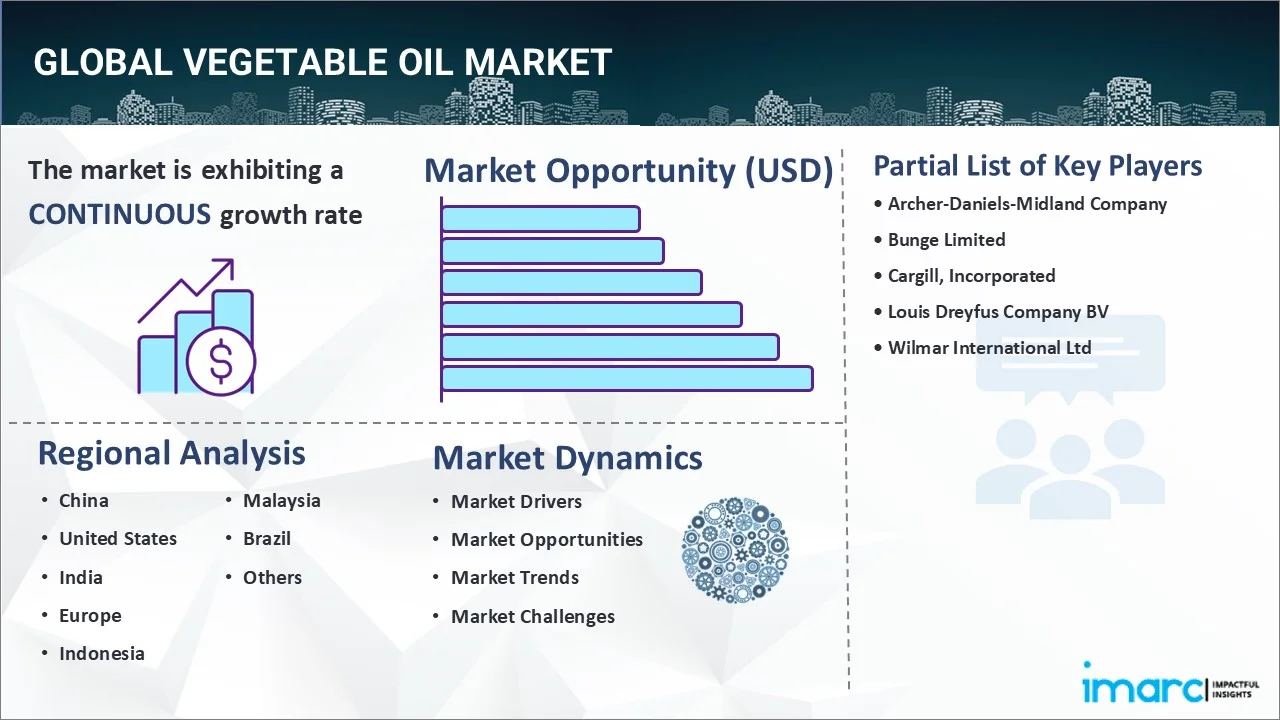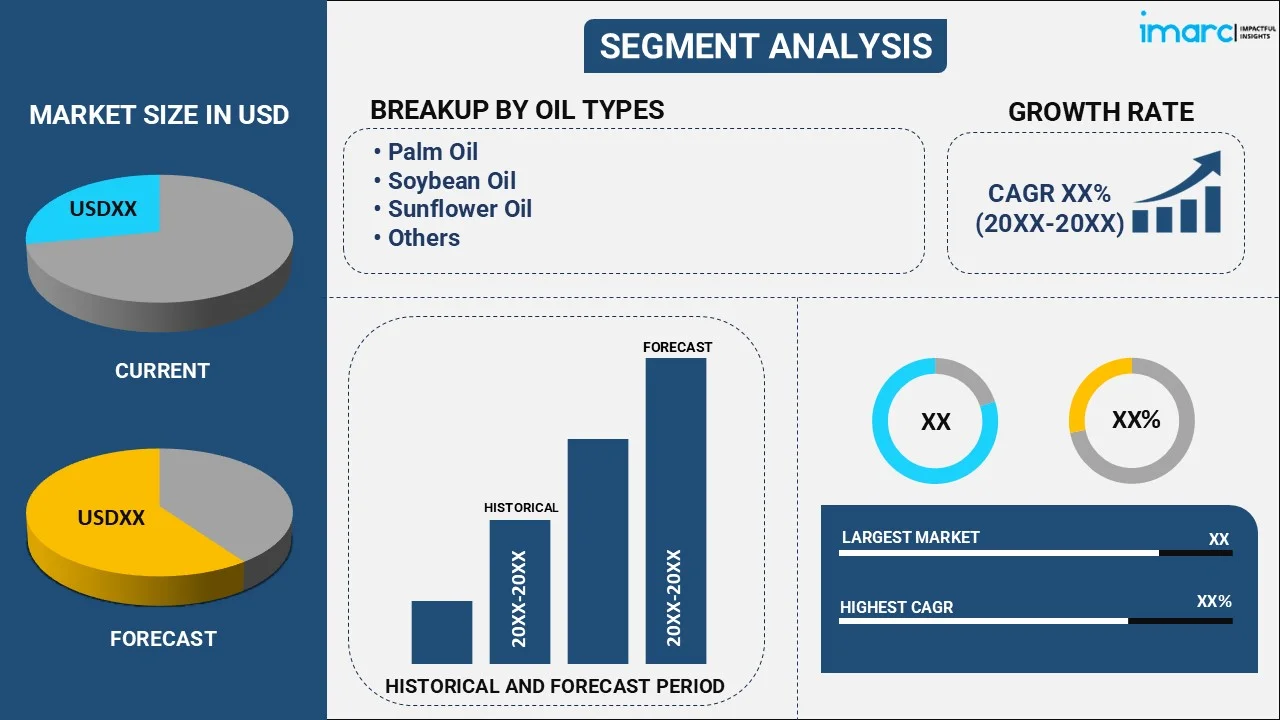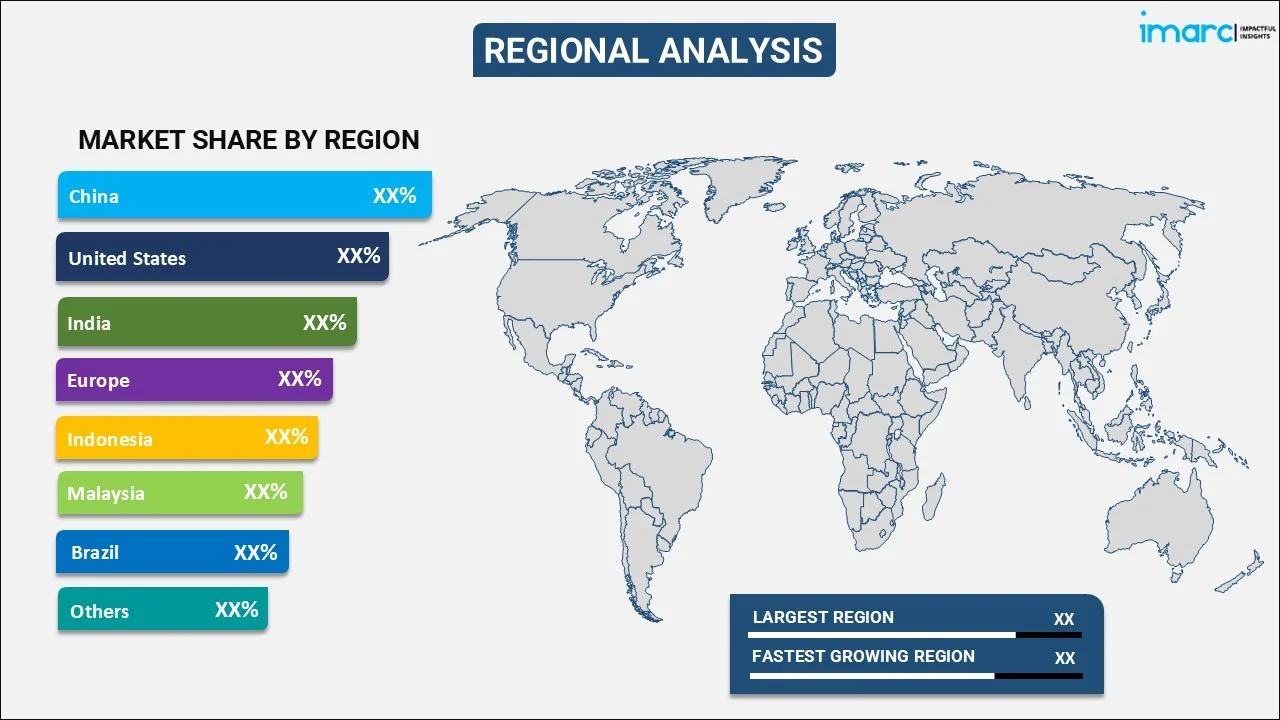
Vegetable Oil Market Report by Oil Type (Palm Oil, Soybean Oil, Sunflower Oil, Canola Oil, Coconut Oil, Palm Kernel Oil), Application (Food Industry, Biofuels, and Others), and Region 2025-2033
Market Overview:
The global vegetable oil market size reached USD 280.5 Billion in 2024. Looking forward, IMARC Group expects the market to reach USD 408.4 Billion by 2033, exhibiting a growth rate (CAGR) of 4.81% during 2025-2033. The rising shift towards healthier eating habits, increasing industrial uses of vegetable oils, advances in agricultural practices, rising disposable income, and increased awareness about the health benefits of certain cooking oils are some of the major factors propelling the market.
|
Report Attribute
|
Key Statistics
|
|---|---|
|
Base Year
|
2024
|
|
Forecast Years
|
2025-2033
|
|
Historical Years
|
2019-2024
|
|
Market Size in 2024
|
USD 280.5 Billion |
|
Market Forecast in 2033
|
USD 408.4 Billion |
| Market Growth Rate (2025-2033) |
4.81%
|
Vegetable oil is a liquid fat extracted from various plants, primarily from seeds or fruits. Common sources include soybean, corn, sunflower, and canola. It is widely used in cooking and baking as a heat transfer medium, flavor enhancer, and ingredient that adds moisture to food. Vegetable oils are also utilized in the production of soaps, skincare products, and biofuels. They are rich in essential fatty acids, though the nutritional value can vary depending on the source. Some vegetable oils are high in unsaturated fats, which are generally considered heart-healthy when consumed in moderation.

Changing consumer preference for healthier oils that are rich in unsaturated fats represents one of the key factors driving the growth of the market across the globe. The market is also driven by the rising health consciousness among consumers which is further influencing the demand for oils like olive and canola. Industrial applications of vegetable oils in cosmetics, soaps, and biofuels are contributing to the market growth. The growing global population and rising incomes in emerging economies are fueling the need for edible oils. Advances in agricultural practices are leading to improved yields, thus making vegetable oil production more efficient and cost-effective. Government policies and trade regulations play a crucial role in shaping the market, affecting production costs and pricing. Distribution channels, including online platforms, facilitate easier consumer access to a variety of oils. Sustainability concerns and ethical farming practices are becoming influential factors in consumer choice which is creating a positive outlook for the market across the globe.
Vegetable Oil Market Trends/Drivers:
Changing consumer preferences for healthier options
In the contemporary health-conscious society, there is a growing demand for vegetable oils that are low in saturated fats and high in unsaturated fats. Oils, such as olive, canola, and avocado oils, rich in monounsaturated and polyunsaturated fats, are increasingly preferred over traditional oils high in saturated fats like palm or coconut oil. Additionally, oils rich in omega-3 fatty acids are finding favor for their proven health benefits. Public awareness campaigns, scientific research, and labeling initiatives are amplifying this trend. Many consumers are making more informed choices based on the health attributes of oils, which is significantly driving market demand for specific types of vegetable oils that are marketed as being healthier.
Rising industrial applications
Beyond the culinary realm, vegetable oils have numerous industrial uses that are considerably widening their demand among consumers. These oils are key ingredients in the production of soaps, detergents, cosmetics, and even biofuels which is further driving the market. The multi-functionality of vegetable oils makes them indispensable in a variety of industrial processes. As industries expand and diversify, so does the demand for vegetable oils. For instance, the rising biofuels sector, particularly biodiesel, is also facilitating the growth of the vegetable oil industry. Companies are also investing in research to discover new industrial applications for vegetable oils, which is further driving its demand.
Rising worldwide population
The world's growing population naturally increases the demand for food and, by extension, cooking oils which is acting as a major growth-inducing factor in the market. As the population rises, especially in emerging economies where incomes are also increasing, more people can afford a wider variety of oils which is contributing to the market growth. The demand for vegetable oils for food production also grows in tandem with the population. Moreover, as global cuisines become more accessible and popular, the oils integral to those cuisines see a rise in demand.
Vegetable Oil Industry Segmentation:
IMARC Group provides an analysis of the key trends in each segment of the global vegetable oil market report, along with forecasts at the global and country levels for 2025-2033. Our report has categorized the market based on oil type and application.
Breakup by Oil Type:

- Palm Oil
- Soybean Oil
- Sunflower Oil
- Canola Oil
- Coconut Oil
- Palm Kernel Oil
Palm oil accounts for the largest market share
The report has provided a detailed breakup and analysis of the market based on the oil type. This includes palm oil, soybean oil, sunflower oil, canola oil, coconut oil, and palm kernel oil. According to the report, palm oil represented the largest segment.
The demand for palm oil in the vegetable oil market is driven by a variety of factors. Primarily, its cost-effectiveness makes it an attractive option for both consumers and industries. Palm oil is one of the most yield-efficient oil crops, which is leading to lower production costs and, consequently, more affordable retail prices. In addition to this, the versatility of palm oil makes it highly desirable across multiple sectors. In the food industry, it is used extensively for frying, baking, and as an ingredient in processed foods like snacks and confectionery items. It also serves as a key ingredient in non-food items, such as cosmetics, detergents, and biofuels, broadening its demand in the market. In line with this, the ease of storage and long shelf life of palm oil adds to its appeal. Unlike some other vegetable oils, palm oil is stable at room temperature, which reduces the need for refrigeration and makes it suitable for tropical climates.
Breakup by Application:
- Food Industry
- Biofuels
- Others
Food industry dominates the market
A detailed breakup and analysis of the market based on the application has also been provided in the report. This includes the food industry, biofuels, and others. According to the report, the food industry accounted for the largest market share.
In the food industry, vegetable oils serve multiple functions that extend beyond mere cooking. They are widely used as frying mediums due to their high smoke points, thus making them ideal for deep-frying items like fries, doughnuts, and various fast foods. Their heat-stable nature makes them a suitable choice for sautéing and pan-frying as well. Vegetable oils are also employed as an ingredient in baked goods, such as bread, cakes, and cookies to add moisture, improve texture, and extend shelf life. Moreover, they act as emulsifiers and stabilizers in processed foods, aiding in the blending of ingredients and preventing separation in products like mayonnaise, dressings, and spreads. Certain types of vegetable oils, like olive oil, are often used as a flavor enhancer in culinary applications, bringing their distinct taste to dishes. In addition, they serve as a base in the production of margarine and vegetable shortening, offering a plant-based alternative to animal fats.
Breakup by Region:

- China
- United States
- India
- Europe
- Indonesia
- Malaysia
- Brazil
- Others
China holds the largest market share
The report has also provided a comprehensive analysis of all the major regional markets, which include China, the United States, India, Europe, Indonesia, Malaysia, Brazil, and others. According to the report, China accounted for the largest market share.
In China, the vegetable oil market is experiencing substantial growth due to several driving factors. Primarily, rapid urbanization and increasing household incomes are leading to a rise in demand for better-quality and diverse food products, including vegetable oils. As lifestyles become more hectic, the reliance on easy-to-cook food, which often requires cooking oils, is also rising. Health consciousness among consumers in the country is growing, which is pushing the demand for healthier vegetable oil options, such as olive and canola oils that are rich in unsaturated fats. The Chinese government's health initiatives and guidelines advocating lower consumption of saturated fats further endorse this trend. Industrial use of vegetable oils in China is burgeoning. With a booming manufacturing sector, the demand for vegetable oils in industrial applications, including biofuels, cosmetics, and even in the pharmaceutical industry, is increasing.
Competitive Landscape:
In the vegetable oil market, key players are engaging in a range of strategic activities to maintain a competitive edge. One of the primary focuses is on product diversification. Companies are introducing a variety of oils derived from different plants to cater to the health-conscious consumer, including options like avocado, grapeseed, and flaxseed oils. Research and development (R&D) are another area of significant investment. Companies are researching new refining techniques, long-lasting shelf-life solutions, and alternative industrial applications for vegetable oils. This not only expands market demand but also allows for innovation within the sector. Sustainability is increasingly becoming a cornerstone of business strategies. Many companies are adopting sustainable farming practices, reducing carbon footprints, and committing to fair trade practices to appeal to environmentally conscious consumers. Market penetration and geographical expansion are also on the agenda. Companies are entering new markets, particularly in developing nations, and enhancing their distribution networks both offline and online to reach a wider audience.
The report has provided a comprehensive analysis of the competitive landscape in the market. Detailed profiles of all major companies have also been provided. Some of the key players in the market include:
- Archer-Daniels-Midland Company
- Bunge Limited
- Cargill, Incorporated
- Louis Dreyfus Company BV
- Wilmar International Ltd
Recent Developments:
- In August 2023, India's vegetable oil imports increased by 46 per cent to 17.71 lakh tonnes in July this year on rise in palm oil shipments, industry body SEA. The country's vegetable oil imports stood at 12.14 lakh tonnes in the year-ago period.
- In August 2023, The Adani Group’s flagship entity Adani Enterprises (AEL) is considering selling its stake in edible oils major Adani Wilmar (AWL), a joint venture between AEL and Singapore-based Wilmar International that is not only the largest edible oil maker in the country but also one of the largest fast moving consumer goods (FMCG) company in India by turnover.
- In November 2021, Edible oil maker Cargill acquired an edible oil refinery located in Nellore, Andhra Pradesh. The $35 million investment to acquire and upgrade the facility will “significantly” expand Cargill's edible oil production capacity and footprint in southern India.
Vegetable Oil Market Report Scope:
| Report Features | Details |
|---|---|
| Base Year of the Analysis | 2024 |
| Historical Period | 2019-2024 |
| Forecast Period | 2025-2033 |
| Units | Billion USD, Million Tons |
| Scope of the Report | Exploration of Historical Trends and Market Outlook, Industry Catalysts and Challenges, Segment-Wise Historical and Predictive Market Assessment:
|
| Oil Types Covered | Palm Oil, Soybean Oil, Sunflower Oil, Canola Oil, Coconut Oil, Palm Kernel Oil |
| Applications Covered | Food Industry, Biofuels, Others |
| Regions Covered | China, United States, India, Europe, Indonesia, Malaysia, Brazil, Others |
| Companies Covered | Archer-Daniels-Midland Company, Bunge Limited, Cargill, Incorporated, Louis Dreyfus Company BV, Wilmar International Ltd., etc. |
| Customization Scope | 10% Free Customization |
| Post-Sale Analyst Support | 10-12 Weeks |
| Delivery Format | PDF and Excel through Email (We can also provide the editable version of the report in PPT/Word format on special request) |
Key Benefits for Stakeholders:
- IMARC’s report offers a comprehensive quantitative analysis of various market segments, historical and current market trends, market forecasts, and dynamics of the vegetable oil market from 2019-2033.
- The research study provides the latest information on the market drivers, challenges, and opportunities in the global vegetable oil market.
- The study maps the leading, as well as the fastest-growing, regional markets. It further enables stakeholders to identify the key country-level markets as well as the fastest-growing markets.
- Porter's five forces analysis assist stakeholders in assessing the impact of new entrants, competitive rivalry, supplier power, buyer power, and the threat of substitution. It helps stakeholders to analyze the level of competition within the vegetable oil industry and its attractiveness.
- Competitive landscape allows stakeholders to understand their competitive environment and provides an insight into the current positions of key players in the market.
Key Questions Answered in This Report
Due to the outbreak of the coronavirus disease (COVID-19) and the consequent lockdowns, there has been a significant decline in the demand for vegetable oil on account of the closure of hotels, restaurants, and catering services.
The global vegetable oil market is expected to exhibit a CAGR of 4.81% during 2025-2033.
The global vegetable oil market reached a value of USD 280.5 Billion in 2024.
The thriving food and beverage industry, coupled with the significant increase in the sales of convenience foods due to hectic lifestyles, increasing disposable incomes and changing dietary patterns, is bolstering the market growth.
One of the leading trends in the global vegetable oil market is the introduction of minimally processed and organic products on account of the rising health consciousness among consumers.
Based on the oil type, palm oil represents the most preferred product. Other major types include soybean, sunflower, canola, coconut, and palm kernel.
On the basis of the application, the market has been classified into the food industry, biofuels, and others. Amongst these, the food industry exhibits a clear dominance in the market.
Region-wise, China holds the leading position in the market. Other major regions include the United States, India, Europe, China, Malaysia, and Brazil.
The leading industry players are Archer-Daniels-Midland Company, Bunge Limited, Cargill, Incorporated, Louis Dreyfus Company BV and Wilmar International Ltd.
Need more help?
- Speak to our experienced analysts for insights on the current market scenarios.
- Include additional segments and countries to customize the report as per your requirement.
- Gain an unparalleled competitive advantage in your domain by understanding how to utilize the report and positively impacting your operations and revenue.
- For further assistance, please connect with our analysts.
 Inquire Before Buying
Inquire Before Buying
 Speak to an Analyst
Speak to an Analyst
 Request Brochure
Request Brochure
 Request Customization
Request Customization




.webp)




.webp)












